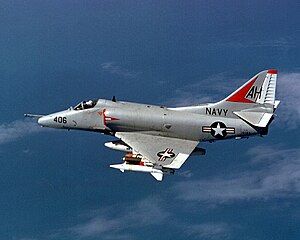| A-4 (A4D) Skyhawk | |
|---|---|
 A U.S. Navy A-4E Skyhawk of VA-164, from USS Oriskany, en route to attack a target in North Vietnam, 21 November 1967 | |
| General information | |
| Type | Attack aircraft, fighter, aggressor aircraft |
| National origin | United States |
| Manufacturer | Douglas Aircraft Company McDonnell Douglas |
| Status | In limited service with non-U.S. users |
| Primary users | United States Navy (historical) |
| Number built | 2,960 |
| History | |
| Manufactured | 1954–1979 |
| Introduction date | 1 October 1956 |
| First flight | 22 June 1954 |
| Retired | USMC (1998), U.S. Navy (2003) Israeli Air Force (2015) Royal New Zealand Air Force (2001) |
| Variants | Lockheed Martin A-4AR Fightinghawk McDonnell Douglas A-4G Skyhawk ST Aerospace A-4SU Super Skyhawk |
The Douglas A-4 Skyhawk is a single-seat subsonic carrier-capable light attack aircraft designed and produced by the American aerospace manufacturer Douglas Aircraft Company, and later, McDonnell Douglas. It was originally designated A4D under the United States Navy's pre-1962 designation system.
The Skyhawk was developed during the early 1950s on behalf of the U.S. Navy and United States Marine Corps as a replacement for the propeller-driven Douglas A-1 (AD) Skyraider. The A-4 is by comparison, a compact, straightforward, and lightweight aircraft for the era. Its maximum takeoff weight of 24,500 pounds (11,100 kg) being roughly half of the Navy's weight specification. The Skyhawk has a short-span delta wing configuration, a tricycle undercarriage, and is powered by a single turbojet engine. The U.S. Navy issued a contract for the aircraft on 12 June 1952. On 22 June 1954, the XA4D-1 prototype performed its maiden flight; it went on to set a world speed record of 695.163 mph on 15 October 1955.[1] On 1 October 1956, the Skyhawk was introduced to operational service.
The Skyhawk's five hardpoints support a variety of missiles, bombs, and other munitions. It is capable of carrying a bomb load equivalent to that of the World War II-era Boeing B-17 bomber, and can deliver nuclear weapons using a low-altitude bombing system and a "loft" delivery technique. Furthermore, it pioneered the concept of "buddy" air-to-air refueling, enabling an aircraft to supply others and reduce the need for dedicated aerial tankers. The Skyhawk was originally powered by the Wright J65 turbojet engine; from the A-4E onwards, the Pratt & Whitney J52 engine was used instead. The Skyhawk was in production through to February 1979, by which point 2,960 aircraft had been delivered to a variety of operators. 555 aircraft alone were built as dedicated two-seat trainers.
The Skyhawk saw active combat on several occasions. The U.S. Navy operated the type as its principal light attack aircraft during the Vietnam War, carrying out some of the first air strikes by the U.S. during the conflict. The Skyhawk was the Israeli Air Force's main ground attack aircraft during both the War of Attrition and the Yom Kippur War. In the Falklands War, Argentine Air Force Skyhawks bombed Royal Navy vessels, sinking the Type 42 destroyer Coventry and the Type 21 frigate Ardent. Kuwaiti Air Force Skyhawks saw action during Operation Desert Storm. In 2022, nearly seven decades after the aircraft's first flight in 1954, a number of Skyhawks[2] remain in service with the Argentine Air Force and the Brazilian Naval Aviation.[3]
- ^ Cite error: The named reference
auto1was invoked but never defined (see the help page). - ^ John, Golan (3 March 2017). "Heinemann's Hot Rod". history dot org. World History Group. Archived from the original on 28 August 2017. Retrieved 28 August 2017.
- ^ "World Air Forces 2022". FlightGlobal. p. 12. Archived from the original on 1 April 2022.